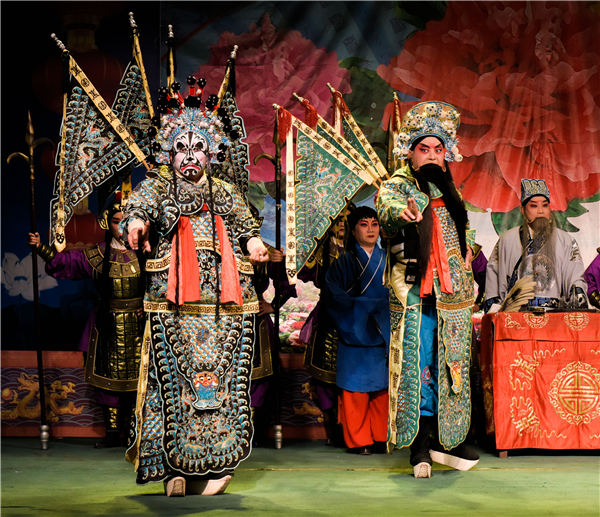
It's around 8 pm. The streets are quiet. For most of Heze, a city in East China's Shandong province, which has a population of around 8 million and is known as the main center for the cultivation of the national flower peony, it is the end of another day.
But one cultural activity center is filled with energy and excitement.
Inside the old, two-floor venue, a crowd is roaring and whistling.
Eight folk opera troupes from the province are performing classic pieces with established stars.
"Usually we go to bed early but today it's like a festival," says a member of the audience who is in his 50s.
Kong Xueqin, a 48-year-old actress from the Erjiaxian Heritage Protection Center in Dingtao county, says: "It's been nearly 10 years since I performed in Heze. I am so excited that the audience still remembers my name and the roles I played."
That night she performs in a classic erjiaxian piece San La Fang. She plays a husband who bids farewell to his wife as he leaves home to take an exam.
Erjiaxian-which features folk melodies, dynamic drumming and sihu (a four-stringed instrument)-is a form of traditional opera with a history that goes back more than 100 years.
It was included in the National Intangible Cultural Heritage list in 2008.
Declining market
Like many traditional Chinese folk opera forms, it was once on the verge of dying out.
"During the past 10 years, there was no market for traditional Chinese folk operas. Local folk opera troupes like ours rarely performed in cities. We had to go from one village to another to make a living," says Kong, who started learning the traditional opera in Heze Art School at age 16.
Kong was born in a small village in Dingtao county, which had only one outdoor stage.
The winters there were freezing and the summer heat was intense.
She recalls that it took half an hour to hike up a narrow street to get to the stage.
But whenever the local erjiaxian troupe visited her village, Kong would get up early, wear her best clothes to go and watch its performance.
"The troupe usually performed after sunset as people were busy with farming in the daytime. I often sneaked backstage and stared at the actors doing makeup," she says.
Wang Tingqi, deputy director of the Shandong provincial department of culture, says: "After many years of silence, folk operas from Shandong province are beginning to breathe again, adding color to local cultural events."
According to Wang, there are 24 folk opera forms in the province, including Peking Opera, liuzi opera, dapingjiao opera and erjiaxian opera, and 18 have been included in the National Intangible Cultural Heritage list.
For the past decade, the folk operas of the province have been overshadowed by TV, movies and computer games.
Some folk opera troupes have folded up because of declining market. But the situation has started to change since the government stepped in.
Training youth
On July 11, the State Council, China's cabinet, issued a directive to support and develop traditional Chinese folk operas.
"We give an allowance to troupe members to guarantee an actor's basic livelihood. To popularize folk operas, we also offer free performances in cities and villages of Shandong," says Wang.
"While maintaining the tradition of classic folk opera, new works, which revolve around contemporary stories and costumes, are also needed," Wang adds.
A local surnamed Zheng says that traditional Chinese folk opera troupes face many challenges.
For example, the audiences are mostly elderly people and the troupes still depend on government subsidies to survive.
He also adds that one of the most important things to ensure that the art form survives is a steady stream of trained young actors.
"Chinese folk operas are highly demanding. Actors need to have training from young. But today's young are easily distracted by other options and only a few can devote themselves to the art fully," Zheng says.
Ma Rui, a 15-year-old student of Shandong Art and Culture School in Jinan, kicks her legs more than 400 times every day.
The student of Shandong bangzi, a 300-year-old folk opera form, which is known for its passionate singing, was introduced to the art form by her father, who is also a Shandong bangzi performer and owns an art troupe.
"I have toured with my father since childhood and my father's troupe is famous in my hometown. It's my dream to become a Shandong bangzi actress," says Ma.
On campus
To generate interest in the younger generation, the local government has been organizing a series of activities called "Folk Arts in Campus" in primary and middle schools of the province since 2009.
An Shigang, principal of Jinan's Weishilu Primary School, says: "We invite professional Peking Opera actors to give our students some basic knowledge about the art form, such as singing and physical actions. During the past five years, the Peking Opera class has become one of the most popular classes among our students."
The principal adds that students are encouraged to further their Peking Opera studies with classes offered by the Jinan Peking Opera Troupe during weekends.
"There is a need to revive traditional Chinese folk operas because they showcase our culture. Stories told in folk operas are basically interpretations of traditional Chinese values and philosophies, such as loyalty, bravery and the virtue of respect. Those are the roots of our spiritual world," the principal says.





